In the previous section, we saw Venn diagrams and union of sets. In this section, we will see intersection of sets.
Intersection of sets
• This can be explained in 9 steps:
1. Let A and B be any two sets.
• We perform an operation called ‘intersection of sets’ between A and B.
2. The set which is formed as a result of that operation,
♦ will contain only those elements which are common to both A and B.
3. The symbol ‘∩’ is used to represent intersection.
• So the intersection of A and B can be represented as A ∩ B.
5. Let us see some examples:
A = {2, 4, 6, 8, 10} and B = {2, 4, 6, 12, 14}. Find A ∩ B.
Solution:
• A ∩ B must contain only those elements which are common to both A and B.
• The elements 2, 4 and 6 are the only elements that appear in both A and B. So A ∩ B will contain only those elements.
• Thus we get: A ∩ B = {2, 4, 6}
• We can represent this intersection using Venn diagrams also.
♦ Fig.1.9(a) below shows A and B before the intersection.
♦ Fig.1.9(b) shows the new set which is A ∩ B.
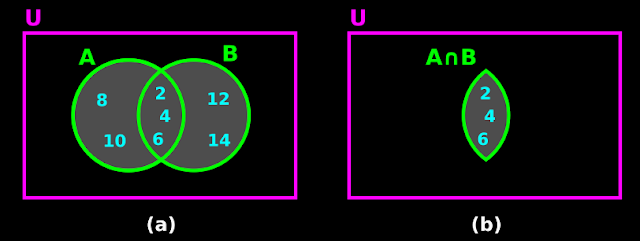 |
| Fig.1.9 |
Let A = { a, e, i, o, u } and B = { a, i, u }. Show that A ∩ B = B
Solution:
• A ∪ B must contain only those elements which are common to both A and B.
• The elements a, i and u are the only elements that appear in both A and B. So A ∩ B will contain only those elements.
• Thus we get: A ∩ B = {a, i, u}
♦ We see that, A ∩ B is same as B.
• We can represent this intersection using Venn diagrams also.
♦ Fig.1.10(a) below shows A and B before the intersection.
♦ Fig.1.10(b) shows the new set which is A ∩ B.
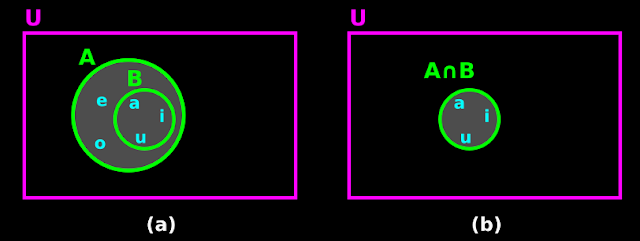 |
| Fig.1.10 |
♦ When the intersection takes place, the resulting set is same as the subset.
♦ We can write: B ⊂ A ⇒ A ∩ B = B
◼ Compare this result with that of the union: B ⊂ A ⇒ A ∪ B = A.
• We see that:
♦ When there is union between superset and subset, the result is same as the superset.
♦ When there is intersection between superset and subset, the result is same as the subset.
7. One more example:
Let X = {Ram, Geeta, Akbar} be the set of students of Class XI, who are in school hockey team. Let Y = {Geeta, David, Ashok} be the set of students from Class XI who are in the school football team. Find X ∩ Y and interpret the set.
Solution:
• We have: X ∩ Y = {Geeta}
• We see that:
The set X ∩ Y consists of members who are both in the hockey team and football team.
8. Thus we can write the definition:
| Definition 7: The intersection of two sets A and B is the set C which consists of all those elements which belong to both A and B. |
• In symbols, we write: A ∩ B = { x : x ∈ A and x ∈ B }
◼ Compare this result with that of the union: A ∩ B = { x : x ∈ A or x ∈ B}
• We see that,
♦ In the case of union, we have 'or' between x ∈ A and x ∈ B.
♦ In the case of intersection, we have 'and' between x ∈ A and x ∈ B.
9. Consider two sets: A = {2, 4, 6, 8} and B = {1, 3, 5, 7}
• There are no elements which are common to both sets. So if we perform the operation of intersection, there will not be any elements in A ∩ B.
♦ That means, A ∩ B will be a null set.
• Any two sets which give a null set when intersection is performed, are called disjoint sets.
• We can write: If A ∩ B = ɸ, then A and B are disjoint sets.
• Disjoint sets can be represented using Venn diagrams as shown in fig.1.11 below:
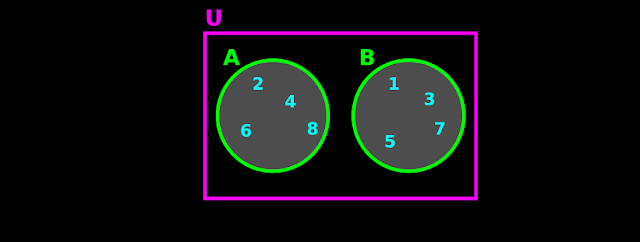 |
| Fig.1.11 |
Some Properties of the Operation of Intersection
1. A ∩ B = B ∩ A (Commutative law)
• This is obvious from fig.1.9 above.
♦ Both A ∩ B and B ∩ A will give the same result in fig.1.9(b).
2. (A ∩ B) ∩ C = A ∩ (B ∩ C) (Associative law).
• This can be proved in 3 steps, using Venn diagrams.
(i) Fig.1.12(a) below shows the three sets A, B and C.
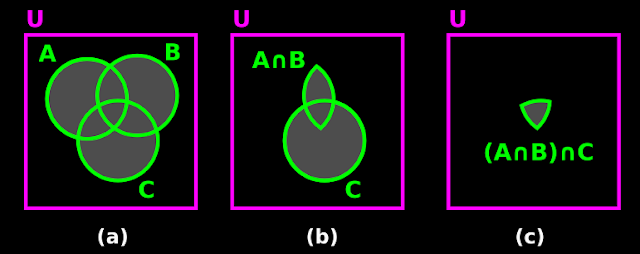 |
| Fig.1.12 |
• Fig.b shows (A ∩ B) and C.
♦ Fig.c shows the intersection between (A ∩ B) and C.
(ii) Fig.1.13(a) below shows the three sets A, B and C.
 |
| Fig.1.13 |
• Fig.b shows A and (B ∩ C).
♦ Fig.c shows the intersection between A and (B ∩ C).
(iii) We see that
♦ Fig.1.12(c)
♦ is same as
♦ Fig.1.13(c)
3. ɸ ∩ A = ɸ (Law of ɸ)
• This is obvious because,
♦ There are no elements common to ɸ and A.
4. U ∩ A = A (Law of U).
• This is obvious because,
♦ 'Elements of A' are the only elements which are common to both U and A.
5. A ∩ A = A (Idempotent law).
• This is obvious because,
♦ 'Elements of A' are the only elements which are common to both A and A.
(6) A ∩ (B ∪ C) = (A ∩ B) ∪ (A ∩ C) (Distributive law)
• This can be proved using Venn diagrams.
(i) The left side of the '=' sign is shown in fig.1.14 below:
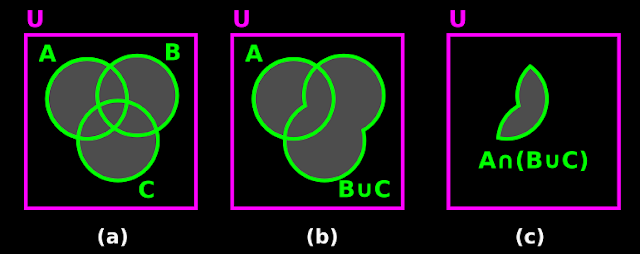 |
| Fig.1.14 |
• Fig.1.14(a) shows the three sets A, B and C.
• Fig.b shows A and (B ∪ C).
♦ Fig.c shows the intersection between A and (B ∪ C).
(ii) The right side of the '=' sign is shown in fig.1.15 below:
 |
| Fig.1.15 |
• Fig.b shows A ∩ C.
♦ Fig.c shows the union between (A ∩ B) and (A ∩ C).
(iii) We see that
♦ Fig.1.14(c)
♦ is same as
♦ Fig.1.15(c)
In the next
section, we will see difference of sets
Previous
Contents
Next
Copyright©2021 Higher secondary mathematics.blogspot.com
No comments:
Post a Comment